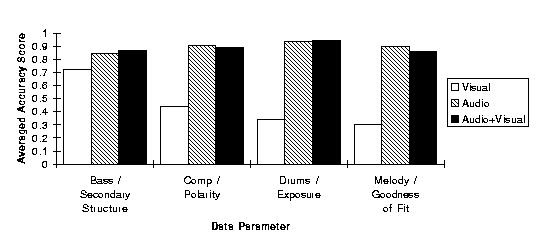 [64K] Partial Image of the gui and the rasmol image
[64K] Partial Image of the gui and the rasmol image
 [4K] Overall results of the experiment showing average accuracy of
prediction with visual, audio, and both used as indicators of the goodness
of the alignment
[4K] Overall results of the experiment showing average accuracy of
prediction with visual, audio, and both used as indicators of the goodness
of the alignment
We present and evaluate PROMUSE: an integrated visualization/sonification system for analyzing protein structural alignments (superpositions of two or more protein structures in three-dimensional space). We also explore how the use of sound can enhance the perception and recognition of specific aspects of the local environment at given positions in the represented molecular structure.
Sonification presents several opportunities to researchers. For those with visual impairment, data sonification can be a useful alternative to visualization. Sonification can further serve to improve understanding of information in several ways. With PROMUSE, data represented visually may be enhanced or disambiguated by adding sound to the presentation. This aspect of data representation is particularly important for showing features that are difficult to represent visually, due to occlusion or other factors. Another feature of our system is that by representing some variables through sound and others visually, the amount of information that may be represented simultaneously is extended. Our tool aims to augment the power of data visualization rather than replace it. Sonification is also useful for tasks such as background monitoring, in which sounds can be used to indicate thresholding events.
To maximize the utility of our sonifications to represent data, we employed musical voices and melodic components with unique characteristics. We also used sound effects such as panning a voice to the left or right speaker and changing its volume to maximize the individuality of the sonification elements. By making the sonification parameters distinct, we allow the user to focus on those portions of the sonification necessary to resolve possible ambiguities in the visual display.
Sonifications of low level data such as raw protein or DNA sequences tend to sound random, and not very musical. We chose instead to sonify an analysis of data features, and thereby present a higher level view of the data. We also used brief melodic phrases rather than single notes in order to generate sounds that were more pleasing and musically idiomatic.
To validate the utility of our system, we present the results of an experiment in which PROMUSE was used to test the use of sound as an aid for clarifying visual information. We also compare the overall effectiveness of visual versus aural information delivery.
 [64K] Partial Image of the gui and the rasmol image
[64K] Partial Image of the gui and the rasmol image
 [4K] Overall results of the experiment showing average accuracy of
prediction with visual, audio, and both used as indicators of the goodness
of the alignment
[4K] Overall results of the experiment showing average accuracy of
prediction with visual, audio, and both used as indicators of the goodness
of the alignment